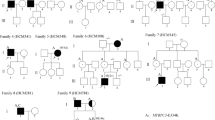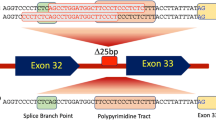Abstract
Genotype-phenotype correlation of hypertrophic cardiomyopathy (HCM) has been challenging because of the genetic and clinical heterogeneity. To determine the mutation profile of Chinese patients with HCM and to correlate genotypes with phenotypes, we performed a systematic mutation screening of the eight most commonly mutated genes encoding sarcomere proteins in 200 unrelated Chinese adult patients using direct DNA sequencing. A total of 98 mutations were identified in 102 mutation carriers. The frequency of mutations in MYH7, MYBPC3, TNNT2 and TNNI3 was 26.0, 18.0, 4.0 and 3.5 % respectively. Among the 200 genotyped HCM patients, 83 harbored a single mutation, and 19 (9.5 %) harbored multiple mutations. The number of mutations was positively correlated with the maximum wall thickness. We found that neither particular gene nor specific mutation was correlated to clinical phenotype. In summary, the frequency of multiple mutations was greater in Chinese HCM patients than in the Caucasian population. Multiple mutations in sarcomere protein may be a risk factor for left ventricular wall thickness.

Similar content being viewed by others
References
Maron BJ (2002) Hypertrophic cardiomyopathy: a systematic review. JAMA 287:1308–1320
Zou Y, Song L, Wang Z, Ma A, Liu T, Gu H et al (2004) Prevalence of idiopathic hypertrophic cardiomyopathy in China: a population-based echocardiographic analysis of 8080 adults. Am J Med 116:14–18
Marian AJ (2010) Hypertrophic cardiomyopathy: from genetics to treatment. Eur J Clin Invest 40:360–369
Konno T, Chang S, Seidman JG, Seidman CE (2010) Genetics of hypertrophic cardiomyopathy. Curr Opin Cardiol 25(3):205–209
Williams JR (2008) The Declaration of Helsinki and public health. Bull World Health Organ 86:650–651
McKenna WJ, Spirito P, Desnos M, Dubourg O, Komajda M (1997) Experience from clinical genetics in hypertrophic cardiomyopathy: proposal for new diagnostic criteria in adult members of affected families. Heart 77:130–132
Simpson DA, Clark GR, Alexander S, Silvestri G, Willoughby CE (2011) Molecular diagnosis for heterogeneous genetic diseases with targeted high-throughput DNA sequencing applied to retinitis pigmentosa. J Med Genet 48(3):145–151
Jordan DM, Kiezun A, Baxter SM, Agarwala V, Green RC, Murray MF et al (2011) Development and validation of a computational method for assessment of missense variants in hypertrophic cardiomyopathy. Am J Hum Genet 88(2):183–192
Van Driest SL, Ellsworth EG, Ommen SR, Tajik AJ, Gersh BJ, Ackerman MJ (2003) Prevalence and spectrum of thin filament mutations in an outpatient referral population with hypertrophic cardiomyopathy. Circulation 108:445–451
Olivotto I, Girolami F, Ackerman MJ, Nistri S, Bos JM, Zachara E et al (2008) Myofilament protein gene mutation screening and outcome of patients with hypertrophic cardiomyopathy. Mayo Clin Proc 83:630–638
Millat G, Bouvagnet P, Chevalier P, Dauphin C, Jouk PS, Da Costa A et al (2010) Prevalence and spectrum of mutations in a cohort of 192 unrelated patients with hypertrophic cardiomyopathy. Eur J Med Genet 53:261–267
Van Driest SL, Vasile VC, Ommen SR, Will ML, Tajik AJ, Gersh BJ et al (2004) Myosin binding protein C mutations and compound heterozygosity in hypertrophic cardiomyopathy. J Am Coll Cardiol 44:1903–1910
Richard P, Charron P, Carrier L, Ledeuil C, Cheav T, Pichereau C et al (2003) Hypertrophic cardiomyopathy: distribution of disease genes, spectrum of mutations, and implications for a molecular diagnosis strategy. Circulation 107:2227–2232
Richard P, Isnard R, Carrier L, Dubourg O, Donatien Y, Mathieu B et al (1999) Double heterozygosity for mutations in the b-myosin heavy chain and in the cardiac myosin binding protein C genes in a family with hypertrophic cardiomyopathy. J Med Genet 36:542–545
Ingles J, Doolan A, Chiu C, Seidman J, Seidman C, Semsarian C (2005) Compound and double mutations in patients with hypertrophic cardiomyopathy: implications for genetic testing and counselling. J Med Genet 42:e59
Girolami F, Ho CY, Semsarian C, Baldi M, Will ML, Baldini K et al (2010) Clinical features and outcome of hypertrophic cardiomyopathy associated with triple sarcomere protein gene mutations. J Am Coll Cardiol 55:1444–1453
Otsuka H, Arimura T, Abe T, Kawai H, Aizawa Y, Kubo T et al (2012) Prevalence and distribution of sarcomeric gene mutations in Japanese patients with familial hypertrophic cardiomyopathy. Circ J 76(2):453–461
Morita H, Rehm HL, Menesses A, McDonough B, Roberts AE, Kucherlapati R et al (2008) Shared genetic causes of cardiac hypertrophy in children and adults. N Engl J Med 358:1899–1908
Landstrom AP, Ackerman MJ (2010) Mutation type is not clinically useful in predicting prognosis in hypertrophic cardiomyopathy. Circulation 122:2441–2449
Tsoutsman T, Kelly M, Ng DC, Tan JE, Tu E, Lam L et al (2008) Severe heart failure and early mortality in a double-mutation mouse model of familial hypertrophic cardiomyopathy. Circulation 117:1820–1831
Acknowledgments
This study was supported by the Ministry of Science and Technology of China (grant number 2007DFC30340 and 2009DFB30050) and by the National Natural Science Foundation of China (grant number 30971233). We thank the patients for participating in the study. We are grateful to Ferhaan Ahmad for critical reading and helpful ideas of the manuscript.
Author information
Authors and Affiliations
Corresponding authors
Additional information
Yubao Zou, Jizheng Wang, Xuan Liu, Lei Song and Rutai Hui contributed equally to the study
Rights and permissions
About this article
Cite this article
Zou, Y., Wang, J., Liu, X. et al. Multiple gene mutations, not the type of mutation, are the modifier of left ventricle hypertrophy in patients with hypertrophic cardiomyopathy. Mol Biol Rep 40, 3969–3976 (2013). https://doi.org/10.1007/s11033-012-2474-2
Received:
Accepted:
Published:
Issue Date:
DOI: https://doi.org/10.1007/s11033-012-2474-2




